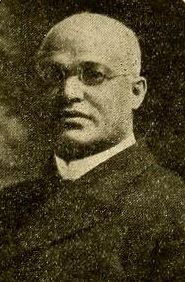
The Methodist Episcopal Church (MEC) was the oldest and largest Methodist denomination in the United States from its founding in 1784 until 1939. It was also the first religious denomination in the US to organize itself on a national basis. In 1939, the MEC reunited with two breakaway Methodist denominations to form the Methodist Church. In 1968, the Methodist Church merged with the Evangelical United Brethren Church to form the United Methodist Church.
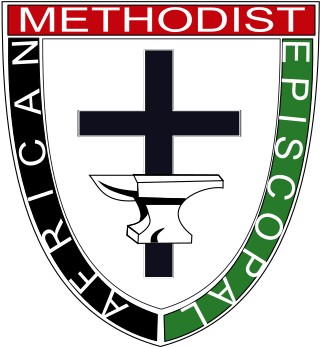
The African Methodist Episcopal Church, usually called the AME Church or AME, is a predominantly African American Methodist denomination. It adheres to Wesleyan-Arminian theology and has a connexional polity. The African Methodist Episcopal Church is the first independent Protestant denomination to be founded by black people; though it welcomes and has members of all ethnicities.

The Christian Methodist Episcopal (C.M.E.) Church is a historically black denomination within the broader context of Wesleyan Methodism founded and organized by John Wesley in England in 1744 and established in America as the Methodist Episcopal Church in 1784. It is considered to be a mainline denomination. The CME Church was organized on December 16, 1870 in Jackson, Tennessee by 41 former slave members with the full support of their white sponsors in their former Methodist Episcopal Church, South who met to form an organization that would allow them to establish and maintain their own polity. They ordained their own bishops and ministers without their being officially endorsed or appointed by the white-dominated body. They called this fellowship the Colored Methodist Episcopal Church in America, which it remained until their successors adopted the current name in 1954. The Christian Methodist Episcopal today has a church membership of people from all racial backgrounds. It adheres to Wesleyan-Arminian theology.

The African Methodist Episcopal Zion Church, or the AME Zion Church (AMEZ) is a historically African-American Christian denomination based in the United States. It was officially formed in 1821 in New York City, but operated for a number of years before then. The African Methodist Episcopal Zion Church adheres to Wesleyan-Arminian theology.
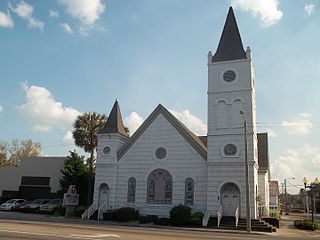
The black church is the faith and body of Christian congregations and denominations in the United States that minister predominantly to African Americans, as well as their collective traditions and members. The term "black church" can also refer to individual congregations.

Lewis Woodson was an educator, minister, writer, and abolitionist. He was an early leader in the African Methodist Episcopal Church (AME) in Ohio and Pennsylvania. Woodson started and helped to build other institutions within the free African-American communities in Ohio and western Pennsylvania prior to the American Civil War.
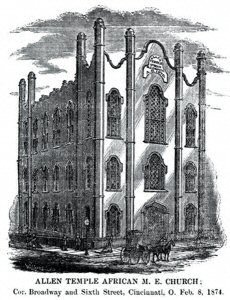
The Allen Temple AME Church in Cincinnati, Ohio, US, is the mother church of the Third Episcopal District of the African Methodist Episcopal Church. Founded in 1824, it is the oldest operating black church in Cincinnati and the largest church of the Third Episcopal District of the AME Church.
James Levert Davis is the 123rd elected and consecrated bishop in the African Methodist Episcopal (AME) Church. He was elected to the office of bishop at the 47th General Conference of the AME Church in 2004. He served as the presiding prelate of the 19th Episcopal district of the church comprising KwaZulu-Natal, Gauteng, Limpopo, Mpumalanga, North West and Free State in the Republic of South Africa. At the 48th General Conference of the AME Church in 2008 he was appointed the Presiding Prelate of the 9th Episcopal District, which comprises the State of Alabama.
The British Methodist Episcopal Church (BMEC) is a Protestant church in Canada that has its roots in the African Methodist Episcopal Church (AMEC) of the United States.

William Henry (Harrison) Heard was a clergyman of the African Methodist Episcopal Church who served as United States Ambassador to Liberia from 1895 through 1898.

William Tecumseh Vernon was an American educator, minister and bishop in the African Methodist Episcopal Church who served as president of Western University beginning in 1896 and Register of the Treasury from 1906 to 1911.

Jordan Winston Early was an American Methodist preacher, he is considered to have been one of the pioneers of African American Methodism spread in the West and South of the United States. In 1868, he married Sarah Jane Woodson Early, and the couple were prominent in spreading Methodism and black nationalism, and his wife taught wherever he preached.
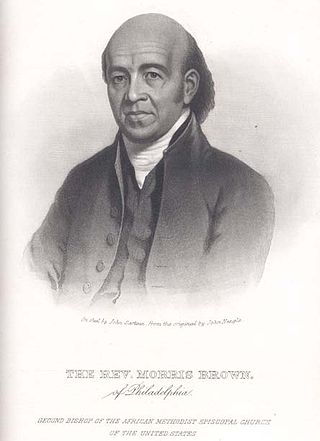
Morris Brown was one of the founders of the African Methodist Episcopal Church, and its second presiding bishop. He founded Emanuel AME Church in his native Charleston, South Carolina. It was implicated in the slave uprising planned by Denmark Vesey, also of this church, and after that was suppressed, Brown was imprisoned for nearly a year. He was never convicted of a crime.

William B. Derrick was an African Methodist Episcopal (AME) bishop and missionary. He worked as a seaman early in his life and served in the Union Navy during the US Civil War. After the war, he joined the AME church and became involved in church leadership and missionary activities. He became a bishop of the church in 1896. He was also involved in Republican politics and civil rights.
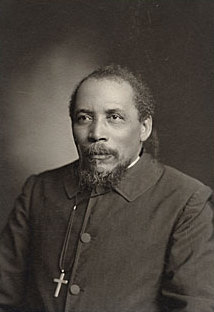
Benjamin Tucker Tanner was an American clergyman and editor. He served as a bishop in the African Methodist Episcopal Church from 1886, and founded The Christian Recorder, an important early African American newspaper.

James Walker Hood was an African Methodist Episcopal Zion Church bishop in North Carolina from 1872 to 1916. Before the Emancipation Proclamation, he was an active abolitionist, and during the American Civil War he went to New Bern, North Carolina where he preached for the church to the black people and soldiers in the area. He was very successful and became an important religious and political leader in North Carolina, becoming "one of the most significant and crucial African American religious and race leaders during the nineteenth and early twentieth centuries". By 1887 he had founded over six hundred churches in Virginia, North Carolina, and South Carolina and erected about five hundred church buildings. He was politically and religiously active as well, supporting education, civil rights, and the ordination of women.
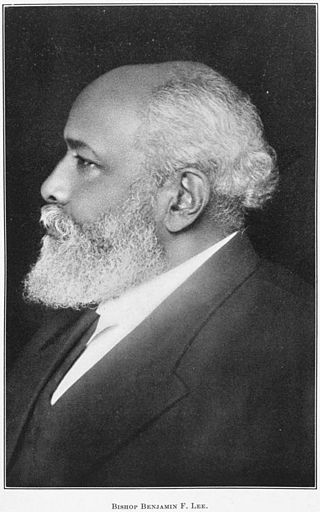
Benjamin Franklin Lee was a religious leader and educator in the United States. He was the president of Wilberforce University from 1876 to 1884. He was editor of the Christian Recorder from 1884 to 1892. He was then elected a bishop in the African Methodist Episcopal (AME) church, serving from 1892 until his resignation in 1921, becoming senior bishop in the church in 1915.
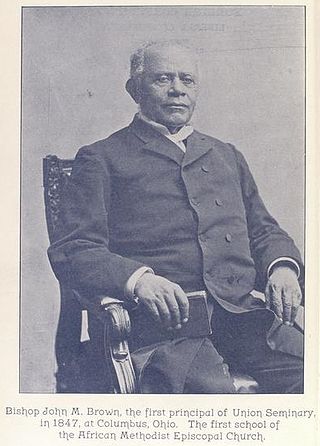
John Mifflin Brown was a bishop in the African Methodist Episcopal (AME) Church. He was a leader in the underground railroad. He helped open a number of churches and schools, including the Payne Institute which became Allen University in Columbia, South Carolina, and Paul Quinn College in Waco, Texas. He was also an early principal of Union Seminary which became Wilberforce University.
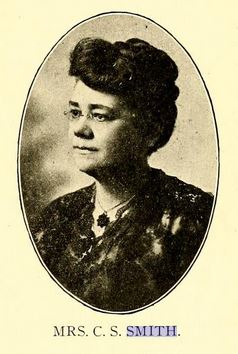
Christine Shoecraft Smith was an African-American community worker began her career as the assistant principal of the Alabama State Normal and Industrial School. She married an AME minister, who would become a bishop in the church and assisted him as the manager of the press organ of the Sunday School Union. She worked in many clubs and served as the 13th president of the National Association of Colored Women's Clubs (NACWC).

Rev. Thomas Marcus Decatur Ward (1823–1894) was an American preacher, missionary, bishop, and abolitionist who aided African-Americans escaping slavery. Ward is considered to have been a central leader of African American religious activity in the 19th-century and has been referred to as “the original trailblazer of African Methodism” in the United States. In 1854, Ward took over leadership of St. Cyprian's African Methodist Episcopal Church in San Francisco. He was an early representative of the A.M.E. church on the Pacific Coast, and he also served as the 10th Bishop of the A.M.E. Church starting in 1868. Ward often went by the name T. M. D. Ward, but was also known as Thomas Mayers Decatur Ward.
